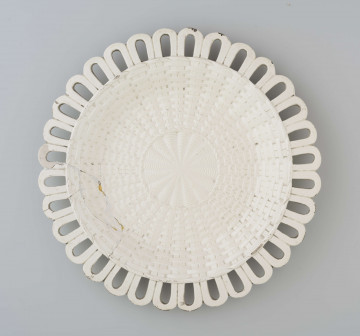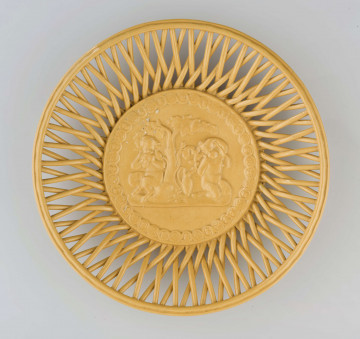
Basket
1800 — 1820
National Museum in Lublin
Part of the collection: English stoneware – Wedgwood
Wedgwood porcelain, from a manufactory located in Staffordshire, is one of the most famous in the world. Founded in 1759 by Josiah Wedgwood, the factory became famous for its ceramics, which date back almost two hundred and fifty years, and the items it produced still delight and find admirers today.
The Wedgwood factory was initially known for its delicate, cream-coloured faience, becoming extremely popular with wealthy clients. In the mid-18th century, it became popular among the great English families to establish large country estates. Elegant residences delighted with their architecture set in extensive gardens and with interiors decorated with grandeur and splendour. Moreover, going from London to the country residences allowed for the organisation of countless social events. The owners of estates, inviting many distinguished guests, competed in many fields, not only in business matters but also in the way they furnished their houses, decorating them with the most fashionable items of high quality, among which the Wedgwood ceramics undoubtedly belonged.
Wedgwood could not afford to let his wares fall out of favour and remained alert to any changes in fashion. In one letter he wrote to his friend, Thomas Bentley, that Lady Dartmouth and her friends were beginning to grow weary of uniform crockery, and were thus seeking new and more interesting designs for their country residences: "You know, however, what Lady Dartmouth reports to us - that she and her friends are already tired of the cream colour" (G. Blake Roberts, Josiah Wedgwood I – człowiek garncarz [Josiah Wedgwood I - Potter-Man, [in:] Wedgwood. Ceramika XVII–XX wieku [Wedgwood. Ceramics of the 17th-20th centuries], Warsaw 2002, p. 23). For that reason, the factory began producing new masses, which depending on the proportions of ingredients added to the clay and the glazes used, were given different colours.
Author / creator
Dimensions
cały obiekt: height: 27 cm, width: 23 cm
Object type
dish
Technique
ceramic technique
Material
ceramic
Creation time / dating
Creation / finding place
Owner
The National Museum in Lublin
Identification number
Location / status

1800 — 1820
National Museum in Lublin

1820 — 1830
National Museum in Lublin

1840 — 1850
National Museum in Lublin
DISCOVER this TOPIC
Castle Museum in Łańcut
DISCOVER this PATH
Educational path